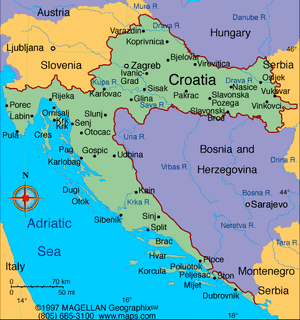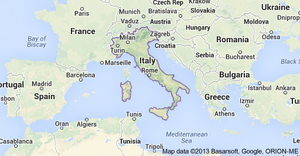Croatia


Croatia (Croatian: Hrvatska) is a unitary democratic parliamentary republic at the crossroads of Central Europe, Southeast Europe, and the Mediterranean. Its capital and largest city is Zagreb. The country is divided into 20 counties and the city of Zagreb.
Origin of name
The name of Croatia derives from Medieval Latin Croātia – compare DUX CRUATORVM [sic] ("Duke of the Croats") attested in the Branimir inscription –, itself a derivation of North-West Slavic *Xrovat-, by liquid metathesis from proposed Common Slavic period *Xorvat-, from proposed Proto-Slavic *Xarwāt- (*Xъrvatъ) or *Xŭrvatŭ (*xъrvatъ).[1]
The origin of the name is uncertain, but is thought to be a Gothic or Indo-Aryan term assigned to a Slavic tribe.[2] The oldest preserved record of the Croatian ethnonym *xъrvatъ is of variable stem, attested in the Baška tablet in style zvъnъmirъ kralъ xrъvatъskъ ("Zvonimir, Croatian king").[3]
The first attestation of the Latin term is attributed to a charter of duke Trpimir from the year 852. The original is lost, and just a 1568 copy is preserved—leading to doubts on the authenticity of the claim.[4] The oldest preserved stone inscription is the 9th-century Branimir Inscription (found near Benkovac), where Duke Branimir is styled as Dux Cruatorvm. The inscription is not dated accurately, however, Branimir ruled Croatia in 879–892.[5]
History
List of islands of Croatia
This is a list of islands of Croatia. There are over a thousand islands in Croatia, the exact number varying by definitions, and they cover a total area of about 3,300 km2.[6]
Northern seacoast
Northern Dalmatia
Central and southern Dalmatia
DNA study on Y-STR Haplogroup Diversity in the Jat Population
David G. Mahal and Ianis G. Matsoukas[7] conducted a scientific study on Y-STR Haplogroup Diversity in the Jat Population of which brief Conclusion is as under:
The Jats represent a large ethnic community that has inhabited the northwest region of India and Pakistan for several thousand years. It is estimated the community has a population of over 123 million people. Many historians and academics have asserted that the Jats are descendants of Aryans, Scythians, or other ancient people that arrived and lived in northern India at one time. Essentially, the specific origin of these people has remained a matter of contention for a long time. This study demonstrated that the origins of Jats can be clarified by identifying their Y-chromosome haplogroups and tracing their genetic markers on the Y-DNA haplogroup tree. A sample of 302 Y-chromosome haplotypes of Jats in India and Pakistan was analyzed. The results showed that the sample population had several different lines of ancestry and emerged from at least nine different geographical regions of the world. It also became evident that the Jats did not have a unique set of genes, but shared an underlying genetic unity with several other ethnic communities in the Indian subcontinent. A startling new assessment of the genetic ancient origins of these people was revealed with DNA science.
The human Y-chromosome provides a powerful molecular tool for analyzing Y-STR haplotypes and determining their haplogroups which lead to the ancient geographic origins of individuals. For this study, the Jats and 38 other ethnic groups in the Indian subcontinent were analyzed, and their haplogroups were compared. Using genetic markers and available descriptions of haplogroups from the Y-DNA phylogenetic tree, the geographic origins and migratory paths of their ancestors were traced.
The study demonstrated that based on their genetic makeup, the Jats belonged to at least nine specific haplogroups, with nine different lines of ancestry and geographic origins. About 90% of the Jats in our sample belonged to only four different lines of ancestry and geographic origins:
1. Haplogroup L (36.8%)- The origins of this haplogroup can be traced to the rugged and mountainous Pamir Knot region in Tajikistan.
2. Haplogroup R (28.5%): From somewhere in Central Asia, some descendants of the man carrying the M207 mutation on the Y chromosome headed south to arrive in India about 10,000 years ago (Wells, 2007). This is one of the largest haplogroups in India and Pakistan. Of its key subclades, R2 is observed especially in India and central Asia.
3. Haplogroup Q (15.6%): With its origins in central Asia, descendants of this group are linked to the Huns, Mongols, and Turkic people. In Europe it is found in southern Sweden, among Ashkenazi Jews, and in central and Eastern Europe such as, the Rhône-Alpes region of France, southern Sicily, southern Croatia, northern Serbia, parts of Poland and Ukraine.
4. Haplogroup J (9.6%): The ancestor of this haplogroup was born in the Middle East area known as the Fertile Crescent, comprising Israel, the West Bank, Jordon, Lebanon, Syria, and Iraq. Middle Eastern traders brought this genetic marker to the Indian subcontinent (Kerchner, 2013).
5.-9. Haplogroups E, G, H, I, T (9.5%): The ancestors of the remaining five haplogroups E, G, H, I, and T can be traced to different parts of Africa, Middle East, South Central Asia, and Europe (ISOGG, 2016).
Therefore, attributing the origins of this entire ethnic group to loosely defined ancient populations such as, Indo-Aryans or Indo-Scythians represents very broad generalities and cannot be supported. The study also revealed that even with their different languages, religions, nationalities, customs, cuisines, and physical differences, the Jats shared their haplogroups with several other ethnic groups of the Indian subcontinent, and had the same common ancestors and geographic origins in the distant past. Based on recent developments in DNA science, this study provided new insights into the ancient geographic origins of this major ethnic group in the Indian subcontinent. A larger dataset, particularly with more representation of Muslim Jats, is likely to reveal some additional haplogroups and geographical origins for this ethnic group.
External links
References
- ↑ Alemko Gluhak (1993). Hrvatski etimološki rječnik [Croatian Etymological Dictionary] (in Croatian). August Cesarec. ISBN 953-162-000-8.
- ↑ Marc L. Greenberg (April 1996). "The Role of Language in the Creation of Identity: Myths in Linguistics among the Peoples of the Former Yugoslavia" (PDF). University of Kansas.
- ↑ Fučić, Branko (September 1971). "Najstariji hrvatski glagoljski natpisi" [The Oldest Croatian Glagolitic Inscriptions]. Slovo (in Croatian) (Old Church Slavonic Institute) 21: 227–254. Retrieved 14 October 2011.
- ↑ Mužić (2007), p. 27
- ↑ Mužić (2007), pp. 195–198
- ↑ Duplančić Leder, Tea; Ujević, Tin; Čala, Mendi (June 2004). "Coastline lengths and areas of islands in the Croatian part of the Adriatic Sea determined from the topographic maps at the scale of 1: 25 000" (PDF). Geoadria. Zadar. 9 (1): 5–32.
- ↑ Y-STR Haplogroup Diversity in the Jat Population Reveals Several Different Ancient Origins
Back to Europe

